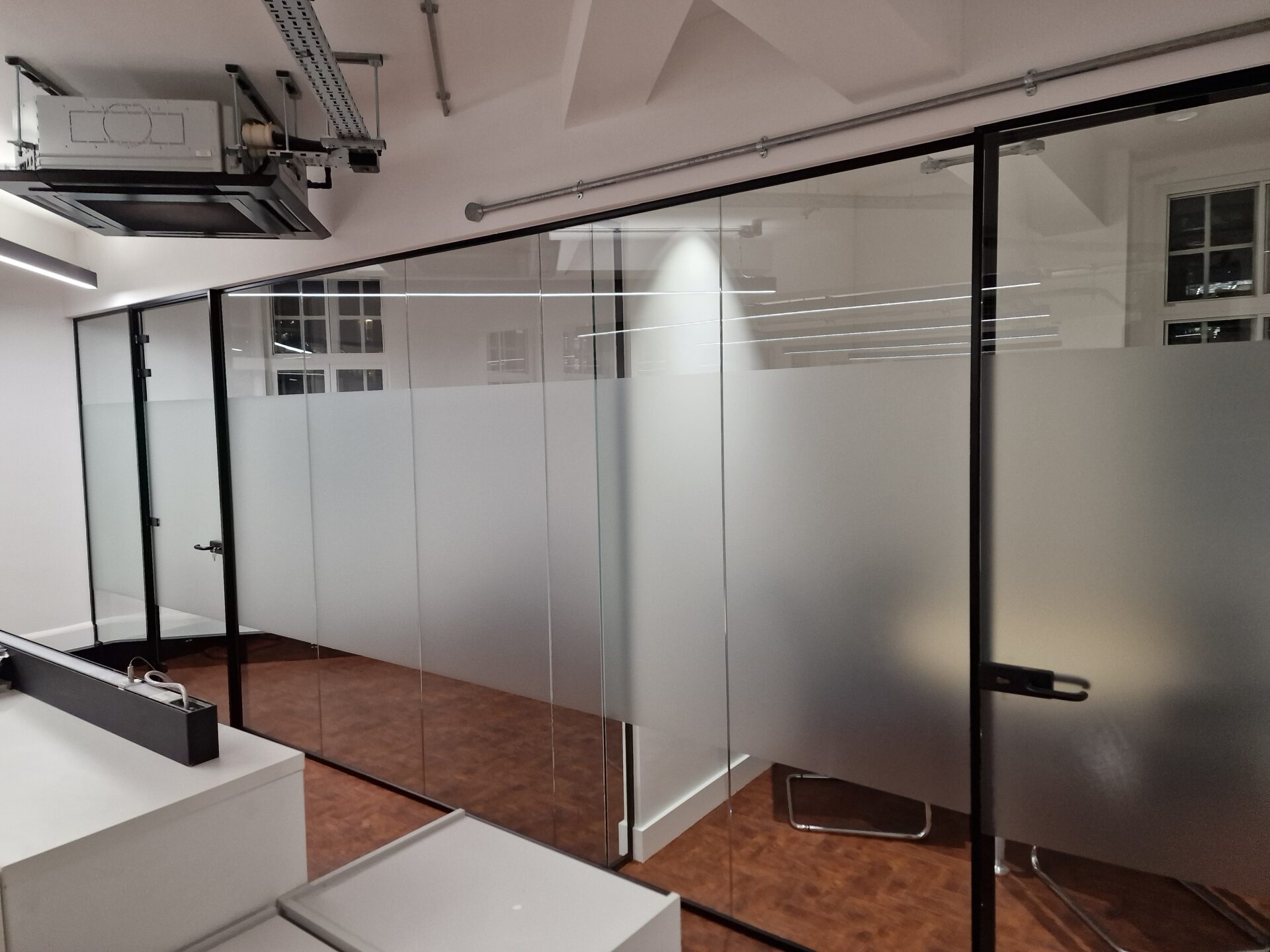
When choosing glass for commercial or residential spaces, understanding the differences between frosted and sandblasted glass is key. Both offer privacy and allow natural light to flow, but they differ in texture, customization, and design impact.
This article will explain the differences between the two, explore their key features and benefits, and help you decide which option best suits your project’s needs.
What is Frosted Glass
Frosted glass is a type of translucent glass created by treating its surface to scatter light and obscure visibility. This is typically achieved through chemical etching or fine sandblasting, producing a smooth, uniform finish. The result is a panel that diffuses light evenly, while blurring what’s on the other side, making it ideal for office partitions, shower enclosures, glass doors, and other areas where both brightness and discretion are required.
Learn More: What is a Frosted Glass
What is Sandblasted Glass
Sandblasted glass is a kind of glass that is created by blasting the glass surface with high-pressure abrasive particles, producing a textured, granular finish. This method allows for intricate designs, gradients, logos, and varying opacity within a single panel. Sandblasting allows for more intricate designs and patterns compared to traditional frosting methods, making it ideal for custom decorative applications. It is ideal for decorative applications, artistic installations, and branded partitions, offering both privacy and flexible light control while adding a distinctive visual element.
Related Read: What is a Textured Glass
Key Features of Frosted Glass
1. Consistent Light Softening: Diffuses natural and artificial light evenly, enhancing interior ambiance without glare.
2. Long-Lasting Finish: The frosted effect is permanent, resistant to peeling, fading, or discoloration, making it ideal for high-traffic areas.
3. UV Protection: Filters harmful UV rays, protecting interiors, furnishings, and artwork from fading over time.
4. Non-slip or Textured Options: Certain finishes provide subtle surface texture, improving grip for doors or panels.
5. Seamless Integration: Works effortlessly with framed or frameless partitions, sliding doors, and other glass solutions for flexible layouts.
6. Branding Opportunities: Can be customized with etched logos, patterns, or graphics to strengthen corporate identity and design aesthetics.
Explore: Frosted Glass Partition
Key Features of Sandblasted Glass
1. Textured and Decorative Finish: Creates a granular, tactile surface that adds visual interest and enhances interior aesthetics.
2. High Customization Potential: Allows intricate designs, patterns, gradients, and logos to be incorporated directly onto the glass.
3. Durability and Safety Options: Can be applied to tempered or laminated glass, ensuring long-lasting performance and compliance with safety standards.
4. Visual Branding Opportunities: Perfect for corporate logos, signage, or decorative motifs in commercial environments.
5. Versatile Applications: Suitable for partitions, doors, windows, decorative panels, and artistic installations in commercial and residential spaces.
Frosted Glass vs Sandblasted Glass – What’s the Difference
| Feature | Frosted Glass | Sandblasted Glass |
| Surface Texture and Finish | Achieved through chemical or acid etching, resulting in a smooth, uniform surface that diffuses light evenly. | Produced by blasting the glass surface with high-pressure abrasive particles, creating a textured, granular finish. Allows intricate patterns and designs. |
| Customization and Design Flexibility | Offers uniform appearance; customization is limited to patterns or full coverage options. | Provides greater flexibility for custom designs, gradients, and logos; allows precise control over opacity and detailed patterns. |
| Light Diffusion and Privacy | Offers consistent light diffusion and privacy across the entire surface, ideal for uniform privacy needs. | Allows control over opacity levels, enabling selective privacy within a single panel. |
| Finish | Smooth, satin-like, uniform | Textured, granular, artistic |
| Privacy Level | Moderate to high, consistent across the panel | Can be varied across the panel for selective privacy |
| Cost | Moderate; cost-effective for large-scale installations | Higher due to customization and intricate design options |
| Durability | Permanent finish, resistant to fading or peeling; can be tempered or laminated | Durable when applied to tempered or laminated glass; surface texture helps conceal minor scratches |
Applications in Commercial Spaces
1. Offices: Frosted and sandblasted glass both serve as effective partitions for boardrooms, meeting rooms, and breakout zones, controlling visibility while letting natural light through. Sandblasted panels offer added flexibility, allowing custom designs or logos to be integrated without compromising privacy.
2. Hospitality: These finishes define semi-private areas in restaurants, hotels, and bars, maintaining brightness while ensuring discretion. Sandblasted glass can include decorative patterns or textures, enhancing the interior design while still functioning as a partition.
3. Retail: Frosted and sandblasted glass are used in fitting rooms, display cases, and partitions, balancing light and visual separation. Sandblasted panels allow for custom branding or intricate designs, adding a distinctive touch to the space.
4. Healthcare & leisure: Both finishes provide privacy for consultation rooms, treatment areas, gyms, and wellness zones. Sandblasted glass can also feature subtle patterns or textures that improve aesthetics while maintaining the same practical benefits as frosted glass.
Factors to Consider Before Choosing
1. Level of privacy needed: Decide how much visibility control is required. Both frosted and sandblasted glass provide privacy, but sandblasted glass allows for selective opacity and custom patterns that can enhance or reduce privacy in specific areas.
2. Branding requirements: If integrating logos, patterns, or designs is important, sandblasted glass offers greater flexibility for customization, while frosted glass can accommodate simpler patterns or uniform finishes.
3. Budget allocation: Frosted glass tends to be more cost-effective for standard applications, whereas sandblasted glass may involve higher costs depending on the complexity of designs or customizations.
4. Cleaning and maintenance preferences: Both types are low maintenance, resistant to fingerprints and smudges, and require only routine cleaning with non-abrasive products.
5. Compliance with safety standards: For high-traffic commercial spaces, ensure that the chosen glass is tempered or laminated to meet safety regulations. Both frosted and sandblasted finishes can be applied to safety-rated glass panels.
Final Thoughts
Frosted and sandblasted glass are versatile solutions for commercial and residential spaces, providing privacy, light diffusion, and aesthetic appeal. While both function effectively as partitions, doors, or windows, sandblasted glass adds extra design flexibility with patterns, logos, and textures. Choosing the right type depends on your project’s requirements for customization, branding, and budget. By understanding their differences and strengths, you can select the glass that best balances style, functionality, and practicality for your space.
FAQs
Yes, sandblasted glass can be used outdoors, including façades, doors, and windows, especially when tempered or laminated for safety and durability.
Frosted glass can reduce some UV exposure, but it does not completely block UV rays. Additional coatings or films may be needed for full protection.
Yes, both finishes can be applied to laminated glass panels to enhance strength, safety, and compliance with building standards.
Sandblasted glass offers greater flexibility for incorporating logos, intricate patterns, or gradients, making it ideal for branding applications.
Both are low-maintenance finishes that resist fingerprints and smudges, requiring only routine cleaning with mild, non-abrasive cleaners.
Durability is largely determined by whether the glass is tempered or laminated. Both frosted and sandblasted glass perform equally well when safety-rated glass is used.














